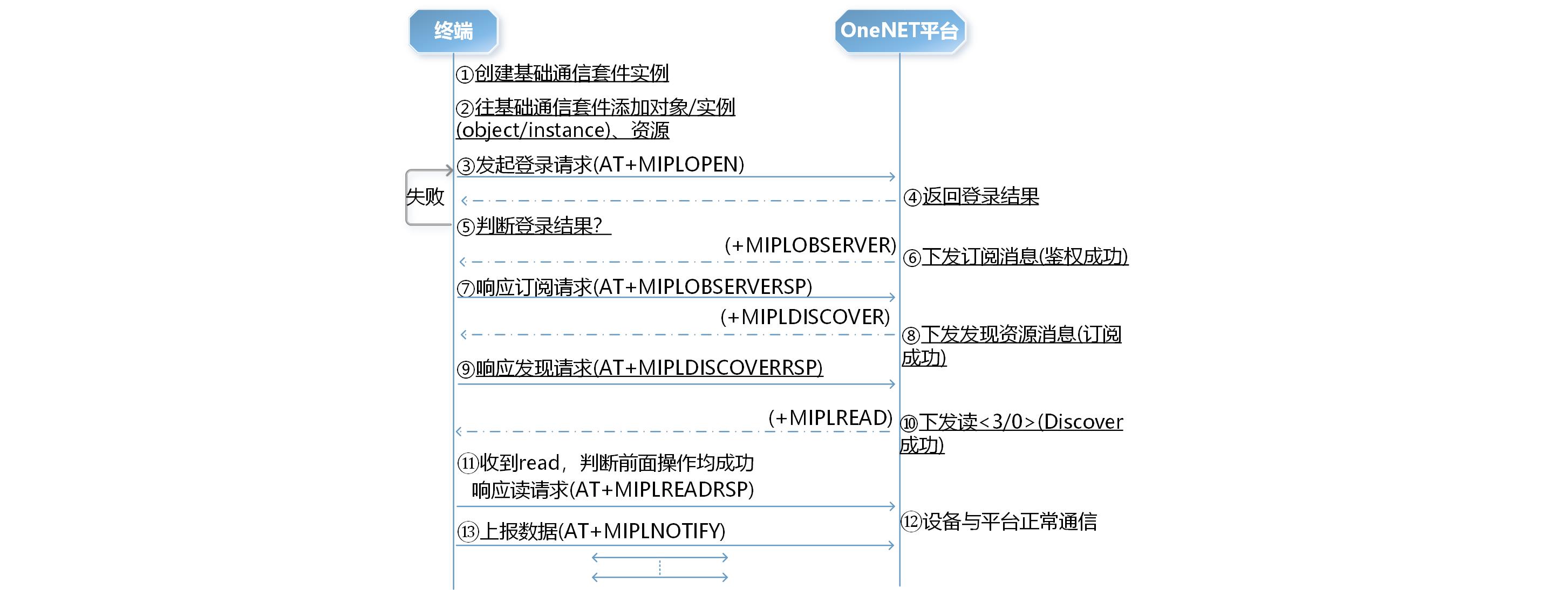
NB-IoT Overview of device access process
You can use NB-IoT Suite to realize fast access to cloud of your device. This process is divided into two stages:
Stage I: access of NB-IoT device to OneNET platform.
Stage II: application development based on the device uploading data stream.
Through the contents in this part, the developer can know about the basic flow for NB-IoT device to be connected to OneNET platform and the flow of application development; for details of the device access process, please check NB-IoT Device Access and Development Guide。

| Stage I: |
The process for the device to be connected to OneNET platform is divided into platform side operation and device side operation.
1、Platform side
As shown in the figure above, after account registration and logon, you can create a product on OneNET platform, the product is equivalent to the collection of certain device. You can add more devices to the product created(/book/get-start/product&device/createDevice.md), Hundreds of device can be added to one product. The device has the same function.
2、Device side
As shown in the above figure, before the terminal device is connected to OneNET platform, you need to finish device development, namely, to finish the transplantation of the basic communication suite SDK provided by OneNET platform on the device side.
⋙ In reality, the main mode of access is:
The terminal device carries the NB-IoT module having been connected to OneNET platform; the user needs to invoke AT instruction provided by the module manufacturer to finish resource manipulation; then the terminal device can interact with OneNET platform through the connection with NB-IoT module, NB-IoT base station, core network and other network elements. ⋙ If you are the module manufacturer that needs to transplant the SDK having been connected to OneNET platform, please click here。
3、Connection of device to OneNET platform
After the terminal device has carried NB-IoT module and realized other service functions, the specific interaction process between the terminal device and OneNET is shown in procedures ① ~ ⑬ in the figure below. Users need only finish the operation on the terminal device side.

After finishing the above procedures, NB-IoT communication module has been successfully connected with OneNET platform, and the device can upload data to the platform through the corresponding AT instruction of the communication module; meanwhile, the module can also receive the command released by the platform.
“Description subscription” and “discover” are optional; the user device can judge whether the “subscription” and “discover” operation is successful by checking whether “read3_0” is received, thereby further judging whether the registration is successful.
4、Use of NB-IoT access service
Users can enter "NB-IoT Suite" through the "developer center" of OneNET platform to realize device management.
| Stage II |
After the device is connected to OneNET platform, device data can be directly reported to OneNET platform. Further, the enterprise application can realize data interaction with OneNET platform through HTTPS/HTTP request/response.
⋙ The basic process is:
OneNET platform provides the encapsulated API interface to the enterprise application;
The enterprise application platform finishes the read/write of OneNET platform and device management request by invoking these API interfaces;
OneNET platform sends the corresponding instruction request to the terminal device;
OneNET platform receives the response data and device information sent by the terminal device;
OneNET platform sends the data and device information to the application platform to finish the response.
The development process for the enterprise application to be connected to OneNET platform is shown in the figure below:

The prerequisite for the enterprise application to realize data interaction with OneNET platform is:
The user has created NB-IoT device on OneNET platform; the device on the platform has the corresponding real device and can report data normally.
2.Development process:
1)The user has developed and deployed the procedure for validation of the access to OneNET platform.
The process for the enterprise application platform to be connected to the validation procedure is as follows:
After OneNET platform finishes the configuration of the third party development platform, it starts URL & Token validation to the enterprise application platform;
The access validation procedure validates the validation parameters sent by the platform;
After validation, the enterprise application platform returns the validation information to OneNET platform;
After OneNET platform receives the validation information, it shows the enterprise application platform has established a connection with OneNET platform.
The address (URL), Token and other parameters for receiving the enterprise application data have been correctly configured on OneNET platform. Token and other parameters Click here to understand the detailed configuration process.
3)Whether the test data can be correctly sent
3. Ability and application expansion
- Rule engine:
Users can define their own data screening rule and change the data format; users are provided with the ability for user-defined message cleaning and message distribution; users can have an access to more value added services of OneNET through the rule engine to realize service expansion fast.
- Data storage:
The platform provides the ability of device data storage, which is convenient for users to realize the storage and query of mass data of device.
- HTTP push:
The platform sends data to the registered address of the enterprise application platform in the form of HTTPS/HTTP POST request, and the data related information sent is inserted to the body of HTTPS/HTTP request in the form of JSON string. When receiving the data, the enterprise application platform will receive the plain text or cipher text of the data.
- Message queue MQ:
This service can provide users with the message acquisition capability of high safety, high stability and high availability. MQ, together with IOT Suite, can form an efficient solution with the capability for device access, device communication, and device message distribution.
- Application editor:
OneNET application editor makes it easier and faster for users to visualize device data streams on the OneNET platform.
- Device management DMP:
Machine card management, remote upgrading, position query etc.